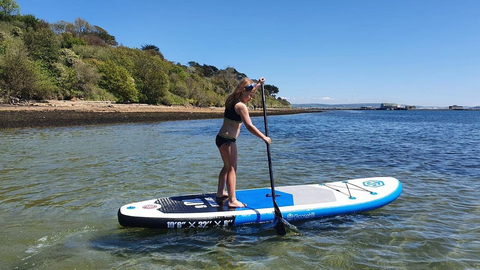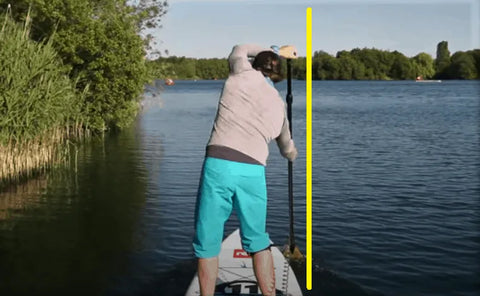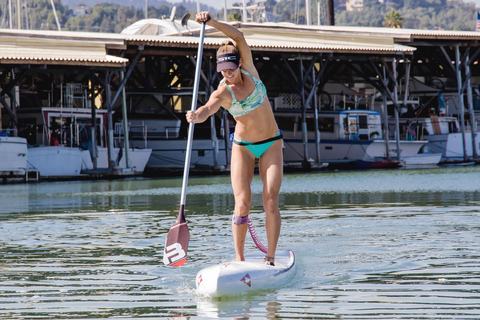Paddle Technique: 6 Steps to Keep Your SUP Straight
Table of Contents
Step1: Use the Right Size Paddle
Step2: Keep Your Paddle Shaft Vertical
Step 3: Check Your Balance
Step 4: Look Ahead
Step 5: Body Rotate While Padding
Step 6: J-stoke
SUP paddling is one of the most important paddleboarding skills. Many beginner paddlers find themselves zigzagging across the lake and quickly growing tired, the need to switch paddling sides after only a few strokes can be maddening.
Once you are able to maintain a straight line while performing multiple strokes on each side of the board, you will definitely find your SUP experience far more efficient and rewarding.
With a few steps, you can learn to move the board just as you want and conserve energy while doing so. You’ll also find that travelling in a straight line takes less effort so you can go further and get more out of your paddling.
Step1: Use the Right Size Paddle
Before you head to the water, you need to be sure you’re using the right length paddle. A paddle that’s too long is cumbersome to use; one that is too short requires you to awkwardly hunch over to get the paddle into the water.
SUP paddle is available in fixed lengths or adjustable lengths. A fixed-length paddle tends to be lighter and stiffer, making it a good choice for long tours and races. An adjustable paddle lets you experiment with the length while you’re learning to SUP, and you can share the paddle with shorter or taller friends and family members.

Step2: Keep Your Paddle Shaft Vertical
In order to paddle in a straight line, think of your blade as a rudder. We want our paddle shaft to be completely vertical the moment our paddle enters the water. Proper vertical stroke form means that one hand is stacked directly on top of the other and both hands are just outside the edge of your board.
To head in a straight line, keep your paddle as close to your board as possible with each stroke. By not holding the paddle in a correct position you may be using it in a way that will push your board side-to-side in the water instead of straight ahead.
But more often than not there’s some wind or current that pushes you in a given direction, so you need to adjust the angle of the blade a bit. Whatever direction you want the board to go, paddle on the opposite side while dropping your paddle to a 45-degree angle over the board (this angle can be adjusted by feel as you continue).

Step 3: Check Your Balance
If you are standing in the right position, your balance will help you maneuver the SUP in a straight line. If you are not in the right position then your weight will not be evenly distributed.
Always stand on the broadest part of the board, which is in the middle. You should check if your feet are at the same distance from the edges before starting your journey.
If one foot is too close to the edge, it is likely to tilt the paddle and lose balance, which would in turn make how to paddle board straight hard. One more thing, you should keep your feet shoulder width apart there.
Step 4: Look Ahead
The mistake many beginners make is being too conscious of how the board is performing, or indeed anxious should they be about to fall off! Once you have your balance on the paddle board settled, and your paddling technique sorted out you should be concentrating on where you are going. If we look down we fall down, but it does also translate and help you to paddle in a straight line if you are looking forward.
When you look ahead, ideally at a fixed point, you’re more likely to be standing in the right position, and you can tell whether or not your SUP is travelling in a straight line. Steering towards a particular view point will automatically give you something to aim at and a direction to go in.

Step 5: Body Rotate While Padding
In order to keep equal weight distribution and attain a vertical paddle stroke, we need to rotate our body during the stroke setup. Body rotation also increases your functional reach, which sets you up for a more powerful stroke. Hence, we need to follow the four steps:
- It is necessary to keep your knees bent all the time
- Turn your upper body away from your paddle, towards your non-paddle side
- Drop your paddling side shoulder. To exaggerate this movement, your head can go between the A-frame of your outstretched arms
- Your top hand must go just over the edge of the paddle board. The paddle shaft and your top are will form the capital letter “A”. You should feel a stretch through your non-paddle side body

Step 6: J-stoke
You’d better start with the conventional “J” if you want to learn the straight-line stroke method, as the mechanics of the J-stroke are easier to master.
Plant your paddle blade a few inches from the edge of the board and pull the paddle closer to the board. Angle your stroke toward the board. Pull the blade slightly inward then let it run and exit close to the board.
The slight inward angle at the beginning helps keep your board moving in a straight line. The J-stroke is an okay traveling stroke but it's inefficient.










